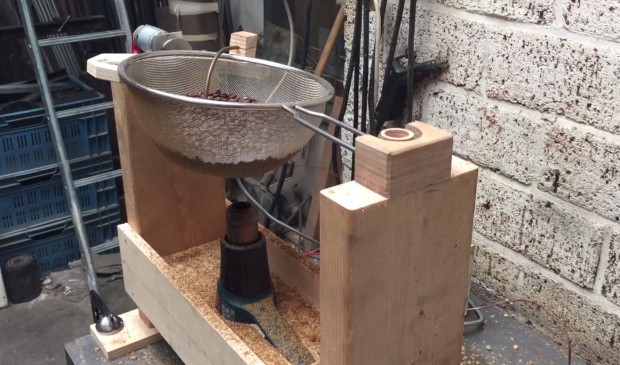Obsessive roasting and brewing tinkerers Frans Goddijn and Tije de Jong have been piece-by-piece assembling a fluid bed roasting machine quite unlike any other out there.
The roaster development project — which follows a kind of open-source coffee ethos shared by Kostverlorenvaart blog author Goddijn and de Jong — is currently being called “Shake, Not Stir,” and it’s based around a homemade fluid bed roaster that the pair hopes could eventually serve as a kind of modular prototype for other home roasters aspiring to have commercial-like features and levels of control during the roast. These are, after all, the same guys who motorized an HG One hand grinder with salvaged Fiat parts, and created this wacky FrankenMoka.
“It’s all basically Tije’s design,” Goddijn said of the latest project. “We were working together on a more or less traditional fluid bed roaster and two prototypes of the chamber did not work very well. Also, the leaf blower engine we used for air flow turned out to be an overkill in flow and not sufficient in ‘static pressure’… it tended to blast beans out of the chamber into the workshop and the heating element could not keep up.”
Rather than building what Goddijn described as a “kindergarten version of a Probat or a Sivetz,” the pair is now experimenting with a third prototype of the new roaster, incorporating incredibly simple components such as a common kitchen strainer with a probe insertion attachment that acts as the bed, an over-the-counter heat gun with a PID attachment for output temperature. Less simple is an engine kit purchased online with a hand-built, retrofitted transmission that powers the aggressive shaking movement throughout the roast.
Open-source Artisan roast-monitoring software has been fitted to the unit, which Goddijn said has been displaying “remarkably ideal roast graphs” since the second prototype. Through those first two prototypes, chaff naturally discarded during the roasting process had been flying every which way, making the Amsterdam studio where this is all happening resemble a freshly-turned snow globe. To address this, for prototype 3, de Jong and Goddijn outfitted the machine with a vortex-creating fan above the roast chamber for reasonably successful chaff collection.
As for where this project is headed, Goddijn said he hopes it can serve to inspire new ingenuity in the home roasting segment. “Tije will probably ensure that the overall design of the concept remains simple, so it retains the charm of simplicity and bare functionality,” he said. “And it will remain an affordable machine, so ideally it could help bring back home roasting to a wide audience. And if the idea remains modular, everyone can develop their own varieties, either sticking to the most bare idea of version 2, roasting outside on a porch and letting the chaff fly where it wants to, or upgrading to a complete system inside a glass cabinet with an exhaust connected to the cooking hood in the kitchen.”
Here is the roaster in action, first with prototype 2 connected to the roast profiling software, then with prototype 3 and the chaff collection system:
[vimeo 138645116 w=620 h=349]
[vimeo 140823055 w=620 h=349]
Nick Brown
Nick Brown is the editor of Daily Coffee News by Roast Magazine.
Comment
2 Comments
Comments are closed.








Will you be selling these?
I love Daily Coffee News. reading over past issues, the ‘Shaken Not Stirred’ (September 29, 2015) coffee roaster which vigorously shakes beans over a heat gun is not a fluid-bed design. fluid-bed is the other type you also featured by Tije (August 23, 2016) that requires lofting the beans in a column of hot air which roasts the beans. fluid-bed requires a strong fan to lift a useful batch of beans. further, the heat source necessary to roast them must be powered by a 224-240VAC circuit, whereas the heat gun (in US) runs on 115-120VAC. both are well executed and very clever, but totally different coffee bean roasting principles.
Larry Cotton
[email protected]